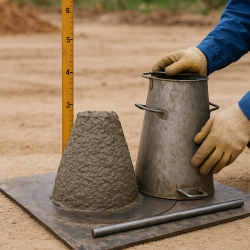The Modern Science of High-Performance Concrete: Mix Design, Quality Control, and Sustainability

Concrete isn’t just a gray slab underfoot anymore—it’s a sophisticated material engineered for strength, durability, and sustainability. For project managers, site engineers, and ready-mix suppliers, understanding the science behind high-performance concrete (HPC) is crucial to stay competitive. Let’s dive in!
The Backbone of Modern Builds
High-performance concrete (HPC) dramatically outperforms conventional concrete, offering:
- Exceptional strength and durability
- Resistance to harsh weather and chemical attacks
- Improved sustainability and reduced lifecycle costs
These properties make HPC ideal for high-stakes structures, from towering skyscrapers to intricate bridge designs.
Breakthroughs in Mix Design
The heart of HPC lies in its precise concrete mix design. Modern formulations often include:
| Component | Typical Proportion (%) |
|---|---|
| Cementitious Materials (cement, fly ash) | 10–15% |
| Aggregates (sand, gravel) | 60–75% |
| Water | 5–10% |
| Admixtures (superplasticizers, silica fume) | 0.5–5% |
| Air (entrained) | 2–8% |
Advanced admixtures like superplasticizers reduce water needs, improving workability without sacrificing strength. Silica fume enhances durability, reducing porosity and increasing compressive strength.
“Mix design innovation directly translates to safer, longer-lasting structures,” says Dr. Emily Chen, a materials engineer specializing in concrete technology at Purdue University.
Field Quality Control: Tests & Best Practices
Robust quality control is critical to ensuring concrete performance matches the mix design. Key tests include:
- Slump Test: Quick and reliable for assessing workability.
- Air Content Test: Essential for durability in freeze-thaw climates.
- Compressive Strength Test: Confirms concrete strength after curing periods.
Follow best practices by adhering strictly to ASTM C94 and ACI 318 standards, regularly calibrating equipment, and consistently training staff on proper testing methods.
Green Concrete & Carbon-Cutting Innovations
Sustainability in construction isn’t optional—it’s mandatory. Innovations in HPC significantly cut carbon footprints by:
- Incorporating supplementary cementitious materials (SCMs) like fly ash and slag
- Reducing cement content, the biggest CO₂ contributor in concrete
- Utilizing recycled aggregates, reducing waste and conserving natural resources
According to research from the Portland Cement Association (PCA), green concrete solutions can slash carbon emissions by up to 40%, making sustainable construction both achievable and profitable.
Case Study Spotlight: One World Trade Center
One World Trade Center exemplifies HPC’s transformative potential. Engineers selected HPC to meet stringent demands for strength, durability, and safety in this iconic structure. The tower utilized a specialized concrete mix with silica fume and fly ash, significantly improving structural resilience and sustainability credentials. The project showcased the crucial role of precision quality control, with constant slump tests and strict adherence to ASTM standards ensuring consistent results throughout construction.
Key Takeaways for Your Next Pour
For site engineers and suppliers, achieving HPC success boils down to:
- Optimizing your concrete mix design with advanced admixtures.
- Rigorous field testing—don’t skip slump and air tests.
- Embracing sustainable solutions for long-term benefits.
- Staying updated on emerging technologies and ACI standards.
Conclusion
As the industry evolves, mastering HPC’s nuances will set construction professionals apart. Looking ahead, continued advancements promise even stronger, greener, and smarter concrete solutions.
Ready to elevate your concrete practices? What innovations are you seeing in your projects? Drop your thoughts below!
References
- American Concrete Institute (ACI 318). (2019). Building Code Requirements for Structural Concrete. Farmington Hills, MI: ACI.
- ASTM International. (2021). ASTM C94: Standard Specification for Ready-Mixed Concrete. West Conshohocken, PA: ASTM.
- Portland Cement Association (PCA). (2022). Sustainable Concrete Practices. Skokie, IL: PCA Research.